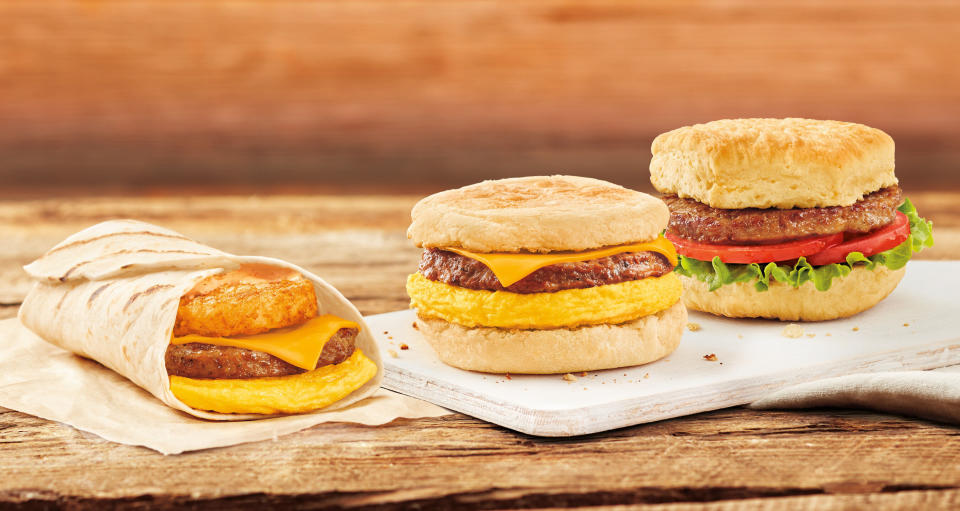Beyond Meat and chicken fingers: Why Tim Hortons is changing up its menu
The death of the retail industry may have been greatly exaggerated – but that doesn't mean the industry isn't currently going through major disruptive and fundamental changes. For this special series, Yahoo Finance Canada will look at how the retail scene is developing, what companies are doing to adapt, and what could come next. Click the image above to see our full coverage of what the future holds for the Canadian and global retail scene.
Over the last several months, Tim Hortons has been busy rolling out a range of new items on its menu.
There was the addition of kids meals, launched in November, featuring chicken strips and grilled cheese. In January, chicken strips were officially added to menu. This month the coffee chain added a $1.99 chicken sandwich, milkshake-type drinks and rolled out three different breakfast sandwiches that feature Beyond Meat’s 100 per cent plant-based patties.
Duncan Fulton, the chief corporate officer with Tim Hortons’ parent company Restaurant Brands International (QSR), says the menu changes are part of an effort to increase brand excitement and traffic at franchises across the chain.

“We’ve been driving menu innovation because it drives excitement about the brand,” Fulton said in an interview at the Retail Council of Canada’s annual Store conference last week.
“The more menu and beverage innovation we can do, the more excitement we build about a brand, and that drives loyalty, that drives traffic and it drives sales increases.”
Maintaining interesting and relevant menus is important for fast food restaurants around the world, particularly as consumers shift towards healthy food choices.
“To meet changing consumer preferences and demands, fast food industry players are faced with the need to innovate and customize menu options as the industry is expected to have a positive outlook until the end of 2020,” a report from Infiniti Research says.
Still, the menu is not the only thing Tim Hortons has been changing lately.
In late April, RBI said it will revamp its iconic Roll Up the Rim contest after the company reported weak sales in the first quarter of the year. In the three month period ending March 31, Tim Hortons saw system-wide sales fall $61 million to $1.55 billion, despite the fact that the quarter coincided with the popular Roll Up the Rim contest.
The coffee chain also launched a loyalty program across the country in March. While Tim Hortons was late to enter the loyalty space, the chain has managed to get 20 per cent of the Canadian population to sign up. According to Fulton, eight weeks into the loyalty program, customers are scanning the loyalty app at a rate of 50 per cent per day.
“The speed of the take-up has surprised us and surpassed all of our expectations,” Fulton said.
“We’re late to the game of loyalty, but we’re going to be a leader.”
Tim Hortons, a brand that has become intertwined and synonymous with Canadiana, is typically recognized for its coffee and baked goods – not plant-based breakfast sandwiches or chicken fingers.
But Fulton says it’s the right move for the company and that it won’t cause any confusion for guests. He compares the menu changes to the daily special at a sit-down restaurant – the most popular dishes tend to make it on to the permanent menu.
“We’re trying to keep things fairly simple so we can use our existing kitchens and systems to make them,” he said. “The ones that do the best will go onto the main menu because it’s what our guests want to buy.”
Before an item lands on the menu and on a customer’s plate, there is typically months of behind-the-scenes development. The company conducts research before developing the product, while also checking in with the advisory board of franchisee members to see if it can be added seamlessly to existing restaurants and, most importantly, if customers will actually like the product. Then the item is tested out in markets before being released across the chain.
Dalhousie University food policy professor Sylvain Charlebois said Tim Hortons has to be cautious when introducing new items to the menu – too many items could complicate the preparation process and increase wait times.
“McDonald’s ran into that problem a few years ago. They had too many menu items, which actually slowed down service,” Charlebois said in an interview.
“That’s the danger Tim Hortons could face by putting too much on their menu... After two or three minutes of waiting, you’re entering the danger zone of dissatisfaction.”
Tim Hortons reputation had suffered in recent years after bitter disputes between franchisees and head office.
Fulton says the company is focused on making sure the Tim Hortons brand “is shining as brightly as it can.”
“That means a ton of beverage and product innovation to maintain excitement with the customer base that knows us extremely well,” Fulton said. “And it’s been working really closely with the franchisees on having a good relationship and getting their advice as we move the business forward.”
Download the Yahoo Finance app, available for Apple and Android.


